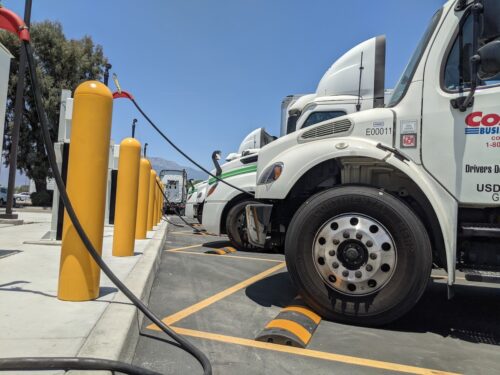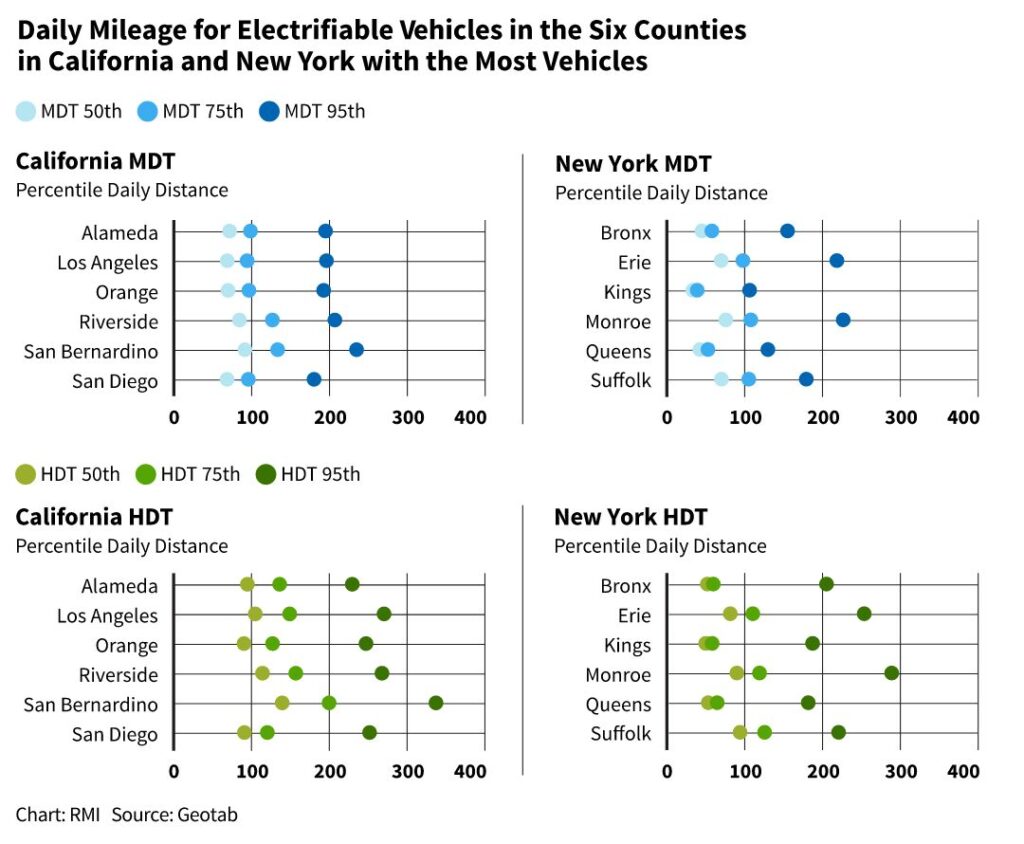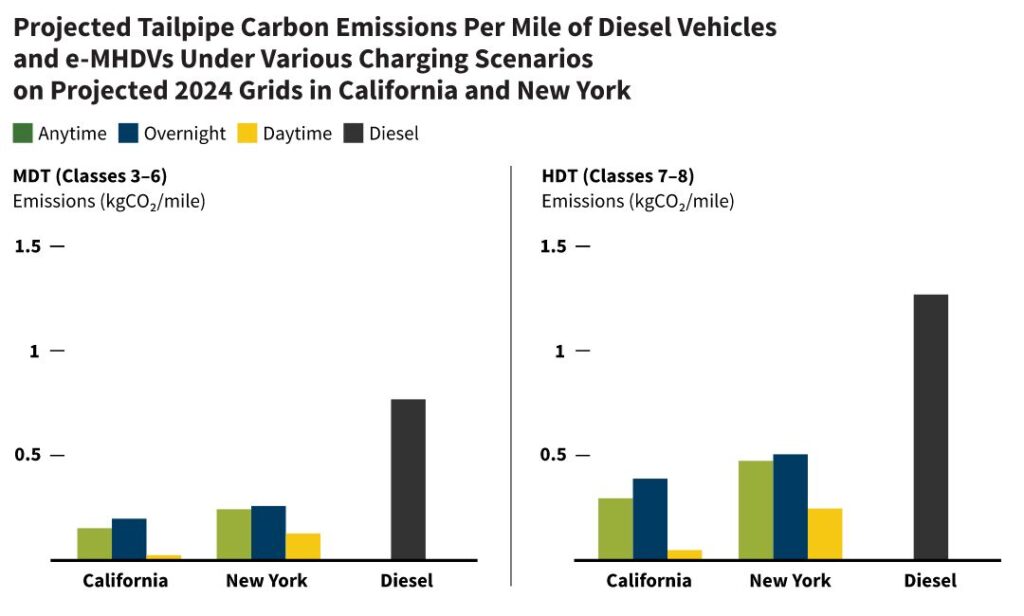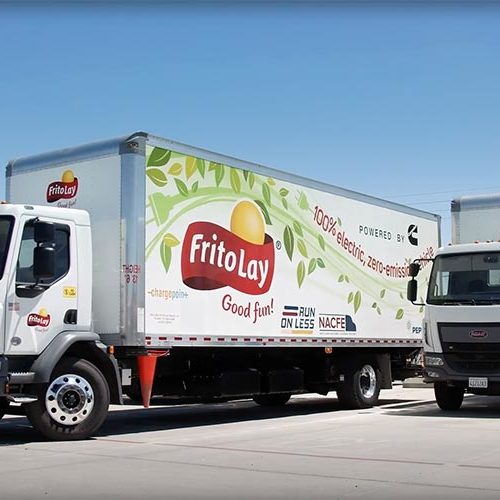photo courtesy Jessie Lund

Electric Trucks Can Move Our Stuff Today
Popular passenger pickup trucks like the Ford F-150 aren’t the only thing going electric. RMI recently determined that a large portion of medium- and heavy-duty (MHD) trucks in California and New York are currently electrifiable, meaning that today’s fossil-fuel powered rigs could be replaced with EVs available now or expected in the coming year.
This is huge news. MHD trucks alone are responsible for close to 25 percent of all on-road transportation emissions. Most of these trucks are used to move freight around the country, covering some 275 billion miles and moving 10 billion tons of goods each year. This is only going to grow, as demand for freight is expected to increase over the coming decades. Although these trucks are critically important to the national economy, we must decrease their emissions. Electrification is a great solution.
Electric Trucks Are Happening
So far, MHD trucking fleets around the United States have committed to deploying over 140,000 electric trucks and there are over 50 electric MHD truck models available around the country. Regulation is further encouraging trucking electrification. In 2020, California passed the Advanced Clean Trucks Act which requires that 100 percent of all new MHD truck sales be zero-emissions vehicles (ZEVs) by 2050 with an interim target of 30 percent ZEV sales by 2030. Fourteen other states and Washington, D.C., signed a Memorandum of Understanding to follow California’s lead. Today, less than 1 percent of new MHD trucks on the road have no emissions, so much work remains to be done over the next 7.5 years to achieve the ambitious targets.
Considering the quantity of emissions coming from trucking and the regulatory push to electrify these trucks, several questions arise. Namely, how quickly can trucks begin to electrify? Which trucks are good candidates for early electrification? What charging infrastructure is needed to support these electric vehicles?
We dug into aggregated and anonymized trucking telematics data from Geotab to get a deeper understanding of how to answer these questions and find out how many trucks could be electrified right now. Based on how freight trucks are driven today, we determined that approximately 65 percent of medium-duty trucks and 49 percent of heavy-duty trucks in California and New York are currently electrifiable.
What Makes Trucks Electrifiable?
We consider trucks to be electrifiable if they travel fewer than 300 miles between trips to their home bases. Today, in the early stages of trucking electrification, public and/or shared truck charging is not widely available so truck charging will largely take place at a truck’s home base. As such, trucks need to visit their home bases regularly to be considered electrifiable.
Furthermore, electric truck range is currently limited to about 250 miles with 300+ mile ranges expected by the end of 2022. Numerous vehicle manufacturers are working on second and third generations of their electric trucks, which will have increased ranges. The latest generation of the Volvo VNR electric has a range of 275 miles and the Nikola Motors TRE truck has an expected range of 350 miles. We limit our definition of electrifiable range to 300 miles because we want to identify the trucks that are going to be electrifiable the soonest while recognizing that not all trucks can be electrified today based on existing technology.
Our definition of early electrifiability — namely traveling less than 300 miles between home base visits — does not consider the economics nor the effect of truck weight on payload capacity. The cost-effectiveness of electrifying these trucks depends on several unknown factors so we did not directly address this in our assessment. However, we think trucking electrification will come faster than many may anticipate. Analysts in this space have traditionally underestimated the cost-effectiveness of new wind and solar technology, and now EV technology is showing a similar curve. Plus, the total cost of ownership of these vehicles will dramatically improve as production gains economies of scale, which we have already seen with light-duty passenger vehicles.
Today, electric trucks generally weigh more than their diesel counterparts. In some cases, this may impact the amount of cargo that a given truck can carry due to federal highway weight limits. As a short-term solution, some states have increased this weight limit for electric trucks. Additionally, the rapid improvements in battery technology over the past decade have led to batteries with higher cell energy density and lower pack weight at lower costs. These improvements mean that electric trucks with longer ranges and lower weights are on the horizon. Furthermore, many trucks fill up their physical cargo space before reaching federal weight limits. So, while electric trucks currently weigh more than similar diesel trucks, this may not impact payloads in all cases.
Today, although a large number of trucks can be electrified with electric trucks that are already on the market, this requires the participation and support of numerous key players, including fleet operators, truck manufacturers, and electric utilities. The technological capabilities of these electric trucks are continually improving. However, fleets and utilities need support to enable rapid trucking electrification. For fleets, managing electric trucks represents a steep learning curve. Utilities can support truck electrification by offering fleet customers free or low-cost advisory services to co-develop charging strategies that minimize overall charging costs, which will benefit the grid and fleets.
Electrifying medium- and heavy-duty trucks offers huge greenhouse gas reduction opportunities compared with diesel powered trucks. With the projected increased freight demand over the next decades, trucking electrification is critically important to ensure that trucking-related emissions do not increase. Learn more about electrifying this trucking sector by downloading the report, Charting the Course for Early Truck Electrification.
Top photo courtesy Jessie Lund



